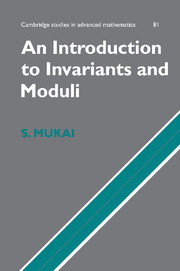Book contents
- Frontmatter
- Contents
- Preface
- Acknowledgements
- Introduction
- 1 Invariants and moduli
- 2 Rings and polynomials
- 3 Algebraic varieties
- 4 Algebraic groups and rings of invariants
- 5 The construction of quotient varieties
- 6 The projective quotient
- 7 The numerical criterion and some applications
- 8 Grassmannians and vector bundles
- 9 Curves and their Jacobians
- 10 Stable vector bundles on curves
- 11 Moduli functors
- 12 Intersection numbers and the Verlinde formula
- Bibliography
- Index
- References
2 - Rings and polynomials
Published online by Cambridge University Press: 05 February 2015
- Frontmatter
- Contents
- Preface
- Acknowledgements
- Introduction
- 1 Invariants and moduli
- 2 Rings and polynomials
- 3 Algebraic varieties
- 4 Algebraic groups and rings of invariants
- 5 The construction of quotient varieties
- 6 The projective quotient
- 7 The numerical criterion and some applications
- 8 Grassmannians and vector bundles
- 9 Curves and their Jacobians
- 10 Stable vector bundles on curves
- 11 Moduli functors
- 12 Intersection numbers and the Verlinde formula
- Bibliography
- Index
- References
Summary
The aim of this chapter is to give a very brief review of the basic algebraic techniques which form the foundation of invariant theory and of algebraic geometry generally. Beginning in Section 2.1 we introduce Noetherian rings, taking as our point of departure Hilbert's Basis Theorem, which was discovered in the search for a proof of finite generation of rings of invariants. (This result will appear in Chapter 4). In Section 2.2 we prove unique factorisation in polynomial rings, by induction on the number of variables using Gauss's lemma. In Section 2.3 we prove the important fact that in a finitely generated algebra over a field an element contained in all maximal ideals is nilpotent. As we will see in Chapter 3, this observation is really nothing other than Hilbert's Nullstellensatz.
A power series ring in one variable is an example of a valuation ring, and we discuss these in Section 2.4. A valuation ring (together with its maximal ideal) is characterised among subrings of its field of fractions as a maximal element with respect to the dominance relation. This will be used in Chapter 3 for proving the Valuative Criterion for completeness of an algebraic variety.
In the final section we discuss Nagata's example of a group action under which the ring of invariants which is not finitely generated – that is, his counterexample to Hilbert's 14th problem. This is constructed by taking nine points in general position in the projective plane and considering the existence and non-existence of curves of degree d with assigned multiplicity m at each of the points, and making use of Liouville's Theorem on elliptic functions.
Hilbert's Basis Theorem
We begin with a discussion of the Basis Theorem, which is the key to Hilbert's theorem of finite generatedness that we will meet in Chapter 4. In Hilbert's original paper [19] the word ideal is not used; and we would like to state the Basis Theorem in a form close to that expressed by Hilbert.
Information
- Type
- Chapter
- Information
- An Introduction to Invariants and Moduli , pp. 51 - 76Publisher: Cambridge University PressPrint publication year: 2003
